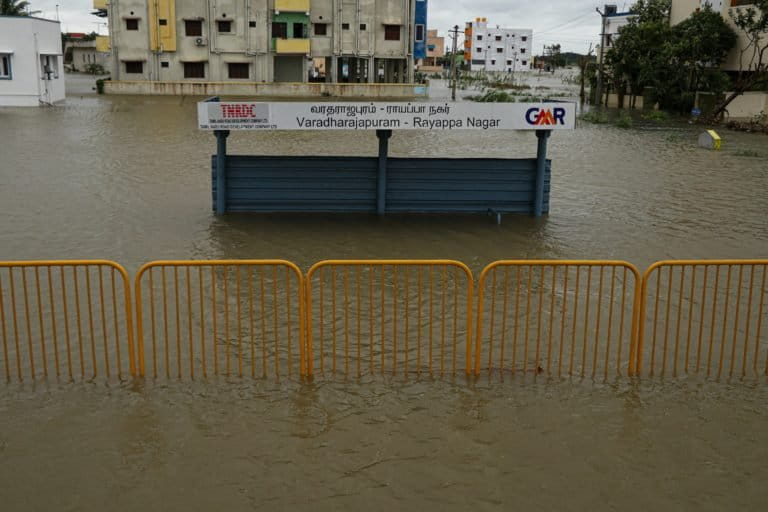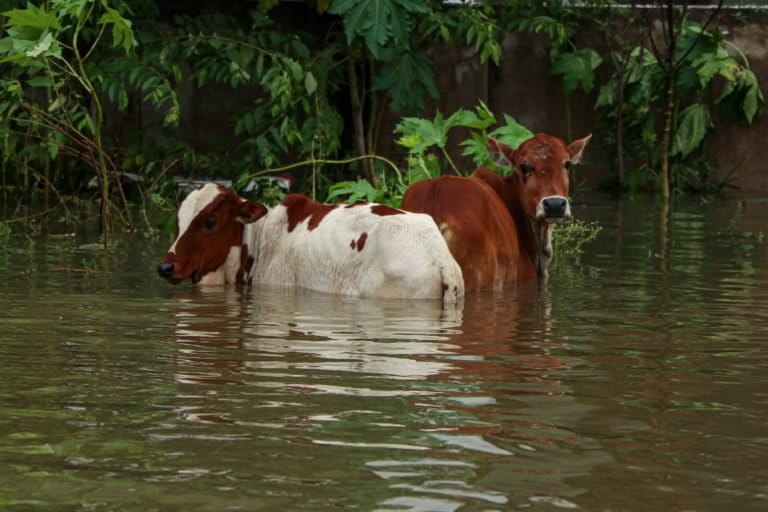- Nivar made landfall on the night of November 25, bringing heavy rains in several coastal and northern districts of Tamil Nadu, southern Andhra Pradesh and Puducherry.
- Over 2.7 lakh people were moved to shelters, loss of life and damage to property was contained. However, farm lands and residential areas were inundated in many districts.
- IMD has issued a fresh alert for a depression headed towards Tamil Nadu, likely to bring heavy rains to South India in the first week of December.
Sathyaseelan, 40, and his family live on the edge of Tamil Nadu’s Ekkiar Kuppam, a fishing village. Cyclone Nivar made landfall at 11.30 pm on November 25 near Marakkanam, barely five kilometres from his hut, which was battered by heavy rain and a turbulent sea.
“We spent over five nights at the shelter,” the fisherman said, as he cleaned the wet floor of his hut. “Every year we end up spending at least a few days there, it is such a problem.”
Nivar rapidly intensified last week, with winds initially touching 85-95 km/hr between Marakknam and Puducherry. However, it weakened into a storm and then a deep depression on November 26 and 27, the Indian Meteorological Department (IMD) said. Heavy rains continued in most of Puducherry, Tamil Nadu and coastal Andhra Pradesh on Thursday, November 26, flooding several districts.
IMD on Monday, November 30, warned that yet another cyclone may be headed towards south India. The depression over the south-east Bay of Bengal was near 710 km from Trincomalee, Sri Lanka and 1120 km from Kanyakumari, India on Monday. IMD said it was likely to intensify into a cyclonic storm in the next 48 hours and bring “extremely heavy rainfall” across southern districts in Tamil Nadu and Kerala on December 1-4. Nivar-affected areas of north Tamil Nadu, coastal Andhra Pradesh, and Puducherry will once again witness heavy rains in this period. Fishermen in Tamil Nadu and Sri Lanka were advised to return to the coast and not venture into the south-west Bay of Bengal and the south-east Arabian Sea until December 4.

“Nivar brought good rains to north and north-eastern parts of Tamil Nadu, and Puducherry. The deficit has come down significantly,” S. Balachandran, Deputy Director General of Meteorology, of the Chennai Regional Meteorological Centre of the IMD, told Mongabay-India. Tamil Nadu’s deficit fell from -23% to -15%. Puducherry witnessed surplus rainfall, with Nivar pushing it over 13%.
“Each cyclone is different, and Nivar was a rain-filled cyclone. It has completely weakened as of November 28,” Balachandran added. Apart from western Tamil Nadu, most of the state has received sufficient rains, he noted. Rains will continue through early December.
The initial prediction was that Nivar could hit anywhere in the 200-km stretch of Mamallapuram, Tamil Nadu and Karaikal, Puducherry.
Limited damage
“Over 30 houses along the shore were submerged in Bommayapalayam (near Marakkanam). This was the worst-affected village,” said Sura Vegadessaperoumal, executive member of National Fishworkers Forum’s (NFF) Puducherry wing. Though Marakkanam’s famed salt pans were flooded, the damage wasn’t severe because it is off-season.
“It’s the houses of our workers which are affected,” Prabhakaran, a salt pan worker in Marakkanam said. “Most are poor, landless Dalit households. It is always difficult for us to get any compensation. Some people are living in shelters now.”
Over 2.7 lakh people were evacuated and moved to 3,042 government shelters on Wednesday, November 25 night by state officials, mitigating Nivar’s impact.
“We were instructed to move people from all low-lying areas on November 23-24,” Suresh Babu, a revenue official from Karaikal, Puducherry, said.
Local officials had been inspecting cyclone shelters beforehand, arranging the movement and rescue of people from low-lying areas and inspecting the damages after the cyclone passed. The National and State Disaster Response Forces were deployed in Tamil Nadu, Puducherry and Andhra Pradesh.
Nivar’s immediate impact was less in comparison to previous cyclones Thane (2011), Vardah (2016) and Gaja (2018). “If we got off easy, it is thanks to sheer providence,” Chennai-based activist Nityanand Jayaraman said.

The initial losses estimated in the agricultural and other sectors are around Rs 400 crores in Puducherry. Tamil Nadu reported four deaths, damages to 118 houses and 10,000 hectares of farmland, and uprooting of 1086 trees. Over 40,000 houses were flooded in Chennai. In Andhra Pradesh, eight people died and over 4.91 lakh hectares of agricultural land was damaged.
“Each cyclone has different characteristics depending on the wind speed, rain-bearing capacity and other parameters. We cannot compare the impacts of Gaja to Nivar,” Balachander said. He added that the impact also depended on what areas are hit, ground conditions and disaster preparedness.
Heavy rains continued in districts of Chennai, Thiruvalluvar, Puducherry, Chengalpattu, Villupuram, and several southern districts of Andhra Pradesh as Nivar, one of the wettest cyclones in recent years, crossed. But the worst may not yet be over as rains may continue in the coastal districts.
Chennai flooded
Chennai, which faces water scarcity every summer, received 808 mm of rains in October and November (until November 28). This is over 32 percent more than usual for this time of year, the IMD noted. There was waterlogging and flooding in several areas in the city.
As capacity in the Chembarambakkam lake, which is a reservoir designed to partially meet the water requirements of the city, upstream of river Adyar before it enters the city, reached 80%, many citizens feared a repeat of the devastating floods of 2015.
However, last week the gates of the lake were opened for the first time since 2015. On Wednesday over 5,000 cusecs of water were released from Chembarambakkam lake into the Adyar river in the south of the city. Local residents were warned and evacuated before the release of water.
In 2015 this lake received the highest inflow in a century, but a delayed and sudden opening of the gates caused severe flooding in Chennai. This time, however, both the municipal and state authorities acted quickly, local residents said. While netizens praised the Chennai Corporation’s actions, there are plenty of criticisms.

Parts of north Chennai, largely comprising densely populated and poorer neighbourhoods in low lying areas surrounded by industries, were heavily flooded for most of the last week. Suburbs such as Semmencherry, Velachery, Varadharajapuram and Mudichur in south Chennai also remained flooded after the cyclone.
“In some areas there was neck deep water even before the cyclone. It was worse afterwards,” said Victoria Raj, a social worker in north Chennai. She said the Cooum river and Buckingham Canal overflowed with nowhere for the wastewater to go. Raj has been wading through waters to rescue homeless people and slum dwellers, and distribute food and blankets.
“When there are heavy rain, winds and storm surge all acting together there is no way for the water to flush out into the sea, because the sea water is pushing in as the rain water pushes out. Such compound events can cause flooding,” Roxy Mathew Koll, a climate scientist at Indian Institute of Tropical Meteorology, told Mongabay-India. The damage caused by such events can be severe.
To top it all, the infrastructure in the city has clogged all major drainage points, Jayaraman noted. “Any amount of tinkering of the drainage system will not be useful if the main arteries – the river basins, creeks and estuaries – are blocked,” he said.
Chennai’s planning authorities have over the years given permissions to construct and raise a city on wetlands, marshlands, river beds and estuaries. Poor urban planning was flagged as a major cause for flooding in the city in a 2017 report by the Comptroller and Auditor General.
COVID-19 infection complicates the process
Pradeep Kumar, 33, is a boxing coach and resident of Vyasarpadi in north Chennai. The roof of his house, made of tarpaulin and discarded flex hoardings, flew away in the harsh winds before Nivar’s arrival. He lives with mother, aunt and grandmother. His mother was recently diagnosed with cancer and diabetes and hasn’t been out of the house thanks to the pandemic, which has also prevented Kumar from taking on new students.
“First, I lost my job because of coronavirus and lockdown, and now my house is completely damaged,” he said, showing pictures of water in his bedroom. “I am so worried that my family will get COVID-19.”
Tamil Nadu has had over 778,000 COVID-19 cases so far, of which Chennai had over 200,000, making it among the worst affected states in the country.
“Social distancing has obviously not been possible at the cyclone shelters,” said Senthil Babu, a researcher at the French Institute of Pondicherry. “A break out of COVID-19 among cyclone-affected communities will be the real disaster, but it’s too early to tell.”
“There has hardly been any physical distancing or mask discipline among the people or officials,” Jayaraman noted.
Activists and officials on the ground said that people were returning home after two days at the shelters, and there are concerns of the spread of the COVID-19 infection. Masks were provided in many shelters, villagers in Villupuram and Cuddalore said. In Chennai, the Corporation has been conducting fever camps for en masse testing of COVID-19.

The WHO recently estimated that between 88 million and 115 million people could fall back into extreme poverty in 2020 as a result of the pandemic and climate change-related events such as cyclones. This is the third cyclone that has hit India amidst the pandemic; Cyclone Amphan hit Odisha and West Bengal in May, and Cyclone Nisarga hit Maharashtra in June.
“The severity and intensity of cyclones, specifically in the Bay of Bengal region, has been increasing as the ocean gets warmer,” Koll said. Tamil Nadu, Andhra Pradesh, Odisha, West Bengal and Puducherry are highly vulnerable to cyclones as India’s east coast sees four times more cyclones than its west.
Livelihoods become even more precarious
“We kept moving the nets and boats inland but the seawater intrusion and the winds kept increasing,” said Bharathi, president, South India Fishermen Welfare Association. The indirect damage to their livelihood is being ignored, he added.
“The storm surge was the worst I’ve ever seen,” Bharathi said. “Fine sand has entered our engines and nets, even though we had wrapped it tightly with plastic. This is now unusable, and we don’t even have a space to sit and detangle our nets.”
Bharathi noted that while the government routinely funds beach beautification projects at the neighbouring Marina beach for the benefit of tourists and citizens, there was little attention paid to fisherfolks’ demands for a shelter to keep their equipment. Fishing equipment is expensive, and can cost upwards of Rs 1 lakh per season.
In villages near Marakkanam, where the cyclone made landfall, fishermen are tired of hauling their boats inland and back.
“We paid Rs 200 per boat to be moved on a tractor. We had to drag it to a safe space and back to the beach,” said Murgesan, a fisherman at Ekiyar Kuppam, pointing to the damages. The government auction house, boat shelter and other infrastructure has been completely damaged here. “We don’t know if they will compensate us for such damage,” he added.

Murgesan and Sathyaseelan were amongst the many fishermen who moved their boats and nets back to the beach on Friday, just hours before the upcoming depression was announced.
Sathyaseelan may have to return to the shelter, but he is more concerned about the disruption to his livelihood. “I haven’t fished for more than a week already, and now they may stop us for a few more days,” he said. “How are we supposed to live and earn if this keeps happening?”
Banner image: Over 2.7 lakh residents were in shelters and camps, and personnel from the Fire, Police and Disaster Management Response Forces were active in several districts. Rescue workers at a residential area in Mudichur, Chennai. Photo by Adaleru Ramamoorthi.
